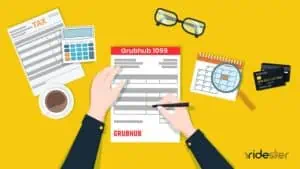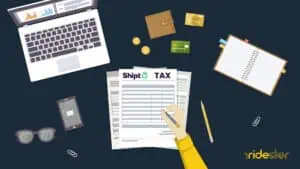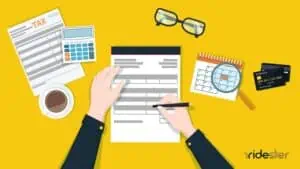Key Takeaways
- All income from Amazon Flex, including tips, must be reported and taxed
- Amazon Flex drivers are classified as independent contractors and are subject to self-employment and income taxes.
- Drivers receive a 1099-NEC form from Amazon for tax reporting and can deduct vehicle expenses.
- We suggest consulting a tax professional’s help and consider using tax software for accurate filing.
Do You Have To Pay Taxes on All Amazon Flex Income?
Yes, you are required to pay taxes on all income earned from Amazon Flex, including earnings from deliveries, Amazon Fresh, and any tips received.
You are considered an independent contractor, and thus responsible for paying both federal and state taxes.
These taxes include the self-employment tax, which covers Social Security and Medicare, applicable if your net earnings are $400 or more, at a rate of 15.30%.
Additionally, you must pay federal income tax, which is progressive and depends on your income bracket. State taxes vary depending on where you live, with some states having no income tax, while others have either a flat or progressive rate.
It’s important to also note that certain expenses related to your work as an Amazon Flex driver may be deductible.
What Tax Forms Do You Get From Amazon Flex?
As an Amazon Flex driver, you will receive a Form 1099-NEC from Amazon, which is used to report your income from Amazon Flex on your tax return.
This form should be mailed to you by January 31st. If you do not receive it by this date, you should contact Amazon to request a copy.
Additionally, you may need to use the Schedule C form to report any business expenses, which allows you to deduct these expenses from your taxes.
The Schedule SE form is also necessary for calculating the self-employment tax you owe.
How to File Amazon Flex Taxes
Now that we’ve gone over the basics of Amazon Flex taxes, let’s take a look at how to file your taxes.
1. Gather Necessary Tax Documents
Collect all required documents, including your Form 1099-NEC from Amazon Flex, Schedule C for reporting business expenses, and, if applicable, your W-2 form if you have additional employment.
Identify whether you are single, married, or head of household, as this will impact your tax bracket and how much you owe.
2. Identify Deductions
Determine your deductions, which can be either standard or itemized. For Amazon Flex drivers, common deductions include vehicle expenses (gas, maintenance, insurance, depreciation) and other business-related expenses (smartphone, office supplies). Use Schedule C to report these expenses.
Maintain detailed records of all business-related expenses, including receipts and mileage logs. Consider using a mileage tracker app or a dedicated business credit card to simplify tracking.
Make Tax Payments
If you owe taxes, choose a payment method that works best for you (check, electronic, debit/credit card). If you expect a refund, the IRS will send it to you.
To avoid a large tax bill in the future, consider making estimated quarterly tax payments on the IRS-specified dates (April 15, June 15, September 15, and January 15 of the following year).
Services To Use for Amazon Flex Taxes
If you find the tax filing process overwhelming, consider hiring a tax professional. They can assist with filing accurately and maximizing your deductions.
- TurboTax: This widely used tax software allows you to easily file your federal and state taxes, including Schedule C for business expenses. TurboTax also offers tools to estimate your quarterly taxes and the option to consult with tax professionals for guidance.
- QuickBooks Self-Employed: Designed specifically for self-employed individuals, QuickBooks helps you keep track of expenses and mileage throughout the year, simplifying tax preparation by keeping your financial information well-organized.
- TaxSlayer: Known for its straightforward interface, TaxSlayer provides an efficient way to file your taxes online. They also offer access to tax professionals who can assist with any queries you might have during the tax filing process.
Brett’s Take: Thoughts From an Expert
A lot of times, Amazon Flex drivers find tax time to be confusing and overwhelming. However, they’re really not that complicated once you break them down.
First, understand that there are tax implications with gig work.
As an independent contractor, Amazon Flex will not take your tax liability out of your paycheck automatically. Come tax time, you’ll be taxed a certain percentage of what you owe.
If you have a W-2 job, your gig work can also bump you up into a higher tax bracket, meaning you could owe more on those earnings.
Second, you can deduct things, especially driving related expenses like gas, mileage, and maintenance.
You should also look into the use of retirement accounts like an IRA to lower your tax bill.
I suggest finding a reliable CPA that can guide you through the process. Taxes are one thing that you DO NOT want to mess up.
The small fee they charge is well worth sleeping well at night knowing that you won’t get hit by a huge tax bill if the IRS decides that you owe more than you reported.
My Suggestion: A few tips to keep in mind:
- Set aside 50% of everything you make for taxes. This ensures that the money you owe is there when you need it.
- Use a mileage-tracking app. There are many apps (such as the Para app) that do this automatically as you drive.






